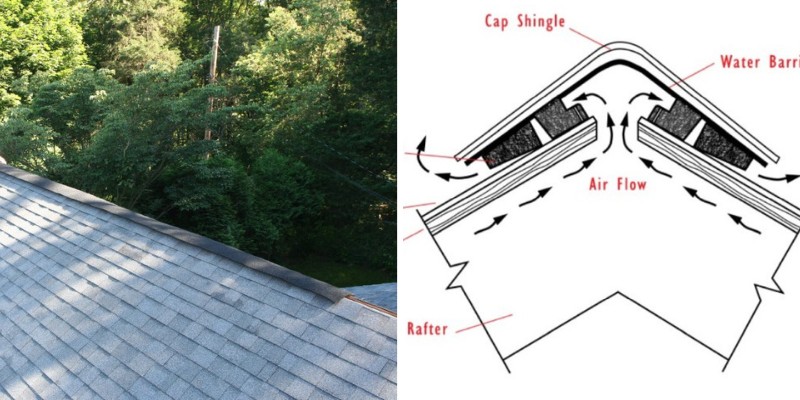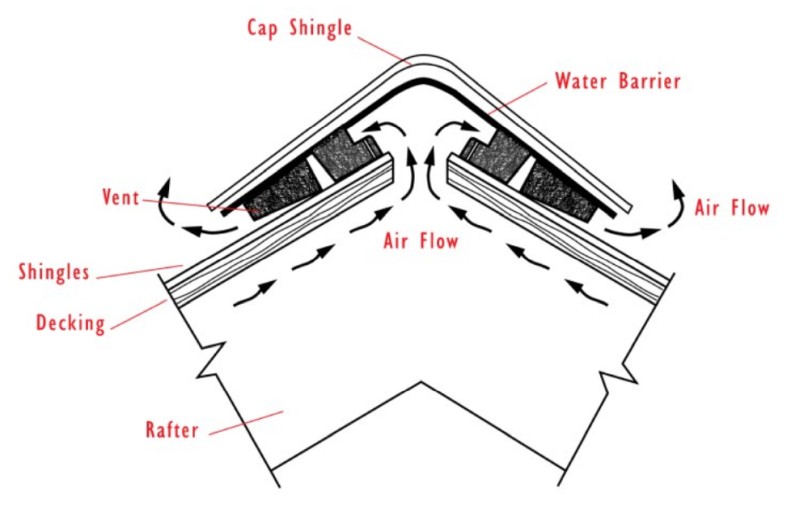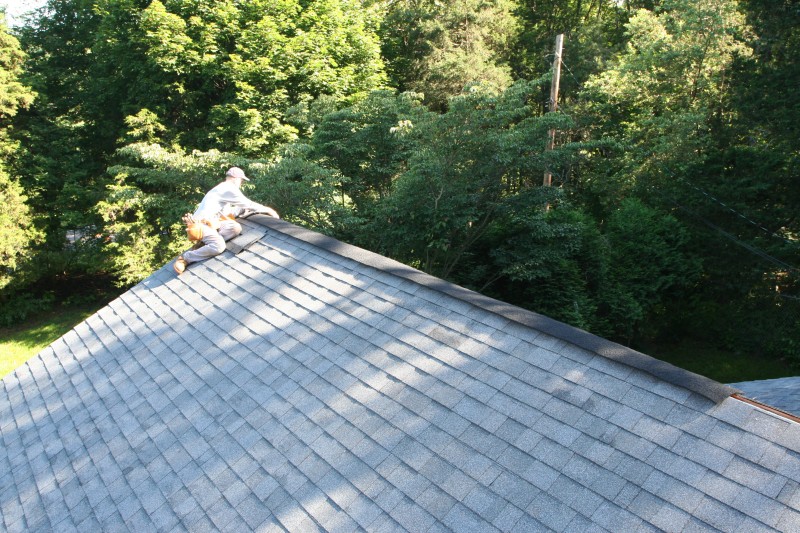Whether you’re a seasoned or first-time home purchaser, your best reassurances that a home is an excellent buy has nothing to do with aesthetics.
You want a home that’s built for efficiency, comfort, and value – and if it also happens to be the most charming home on the block, you’ll know you’ve applied due diligence to your search.
What are the most critical aspects of a house? A solid foundation. High-quality construction. State-of-the art infrastructure and a neighborhood that reassures you that the home will hold its value over time.
But one of the most important aspects of a home purchase is making sure there’s a world-class roof protecting everything beneath the eaves that has been fitted with a proper venting system.
You may be surprised to learn how many benefits a homeowner enjoys once the right roof venting system is in place.
In this article we’ll discuss the pros and cons of ridge vents which is one of the popular roof vent options for residential homes.
Why are Roof Vents Important?
Vents keep attics cooler in summer months, increase airflow, decrease the amount of mold, rot and other damages that have the potential to shorten both tile and roof’s lives.
The right vent helps keep energy bills low, too. Will a single vent do the job properly? If your home is very tiny it might, but you’ll probably need more of them to service a larger abode.
Here’s your short tutorial: You’ll need one vent installation (1 sq ft) for every 300 square feet of ceiling space for homes that have been fitted with vapor barriers. You’ll need one sq ft vent for every 150 square feet of ceiling space for homes with no vapor barriers.
Of course, nothing about home ownership is simple, thus you may be given roof vent options by your contractor thanks to a growing selection of venting systems on today’s market.
He may suggest a wind turbine, power vent, box vent, cupola vent or soffit vent, but it’s also likely your professional will recommend a ridge vent because this type is considered by some experts to be one of the best options depending on your roof type, climate etc.
What is a Roof Ridge Vent?
This is a type of air exhaust vent that gets its name from its location: It’s literally installed at the peak of the roof and usually takes up the whole roof length.
Though the air slot itself is covered by the vent, a continuous flow of hot air is uniformly released from the attic’s highest elevation.
Ridge vents are designed also to circulate interior air and depending upon your climate and the direction your house faces, this vent type offers both wind-driven rain and snow resistance protections. It keeps away insects and debris from infiltrating the home as well.
Typically shielded by ridge cap shingles, ridge vent installation doesn’t detract from the roof’s appearance, nor will it alter the architectural design of the house itself.
Considered a “passive system,” ridge vents require no additional source of energy to do the job, perhaps the best feature of all given soaring energy prices.
Additionally, who doesn’t love the feeling of efficient natural air circulation throughout a home powered by Mother Nature rather than your local utility company?
Main Advantages of Roof Ridge Vents
1. This type of vent produces a natural, efficient exchange of air
Air circulation is critically important to homeowners because when breezes and winds move air over roof lines, air pressure changes, a process that naturally helps draw hot air from attics where it can build up and impact everything from comfort levels to increased energy expenditures.
As this exchange takes place, cool air moves through the underside of the roof ridge vent via this natural air exchange.
2. Ridge vents help maintain a home’s temperature
Because hot air rises, attics, second and third stories of buildings tend to be much warmer than first stories and basements, but by adding a ridge vent to your roof, you help moderate interior temperatures because air natural movement helps the hottest air escape.
Given this dynamic, homes remain cooler and can help residents reduce dependence upon air conditioning, which reduces energy costs, thus roof ridge vents are very energy efficient.
3. Ridge vents keep rodents outside where they belong
Due to their unique design, unlike older styles of roof vents, ridge vents won’t permit critters to sneak into your attic.
Clever squirrels, mice, racoons, and moles are adroit at finding entry points on roofs that feature other types of roof vents.
Because this style of vent keeps rodents from seeking shelter in your attic, you avoid having to set traps, worry about damage and health issues that can occur when these heat-seeking creatures gain entry.
4. You won’t require other ventilation assistance with roof ridge vents
Life is complicated and the fewer systems you need to worry about, the less complicated home ownership becomes.
Because roof ridge vents don’t need HVAC systems to be operated for best results, moisture release and mold or mildew growth are avoided without running up your power bill.
As an additional perk, this vent type isn’t vulnerable to electrical or mechanical failures.
5. Your home’s appearance won’t be ruined by an unsightly vent
Given the inventive engineering associated with roof ridge vents and the availability of roof tiles that disguise the portal that circulates the air in your home, your home’s design won’t be ruined by the addition of a less discreet vent installation.
In fact, when one is standing in front of a home or in the backyard, it can be hard to spot the area where one or more vents are positioned along the ridge line.
6. Your family stays healthier and little maintenance is required
Having already learned that you can improve the air quality within your home by installing a roof ridge vent, you could be surprised to discover that there’s relatively little maintenance involved once your vent is in place.
Given the fact that air pollution is one of the most concerning environmental factors our society must deal with, this choice of vent offers health benefits too:
Thanks to the efficiency of this system, you could experience fewer respiratory reactions in family members who are sensitive to pollutants in the air.
Main Disadvantages of Roof Ridge Vents
1. Ridge vents don’t always deliver on enhanced ventilation
Despite the marketing rhetoric, delivering on enhanced ventilation is only possible when a home is designed specifically for energy-efficiency, thus an old house may not be capable of taking advantage of this vent type.
Further, if a contractor doesn’t recommend the installation of baffles, a homeowner may get no ventilation benefits at all — even if “the flow of air is correct,” noted one professional.
2. This vent type requires professional installation and it’s more expensive
Factoring in geographic location and house size, count on spending a minimum of $500 to install a roof ridge vent.
If your roof design is out-of-the-ordinary, you could spend three times that amount.
Old homes will require additional fixes to maximize the benefits of this type of vent and not every roofer has the experience required to do a proper job of making this modification.
3. Ridge vents are designed to work on sloped roofs
If your roof is flat, you will want to cross this vent type off your list. Sloped roofs provide the gently graduated sides that create the roof ridge for which this style of vent was created.
The operative word is gently since roof shape determines how much air flows through the system.
If your home’s roof is too steep, you’ll be spending a lot of money for a feature that won’t function optimally and may even add to your ventilation woes.
4. Mostly Appropriate for Shingled Roofs
For structures that have been crowned with non-traditional materials, installing a roof ridge vent is another way to throw your money out the window.
Roof ridge vents were specifically designed to coordinate with shingles so if your roof has an exotic pedigree like stone-coated metal, single-ply roofing material, standing seam, a built-up roofing system or you have installed solar shingles, rely upon your contractor to suggest an alternate vent.
5. May not be the best choice for homes in warmer climates
If you live in a city like Miami or Phoenix, you may wish to think twice about installing a roof ridge.
This type of ventilation system has been proven to work most efficiently in colder climates.
In fact, the colder the climate, the more an attic area benefits from the ventilation delivered by one or more roof ridge vents.
That’s not to say that this vent won’t suffice, but as one contractor wisely said, “there are cheaper and more effective” systems to consider for folks living in warm climates.
Do Ridge Vents Leak?
Weather forecasts reflect a changing ecological environment and if your area of the country is already known for heavy rains and storms, you can’t control the way or amount these forces of nature will behave when they meet up with even the best-constructed ridge vent system.
Further, the positioning of your home can make a major difference in how much water incursion a homeowner can expect when sheets of rain blow directly into the vent(s).
In most cases, a well-installed ridge vent should hold up well, but if your area is prone to more extreme weather patterns and water damage is already a problem in your area, you may wish to find a different style of vent that produces a more water-tight result for your roof – especially if it takes very little water incursion to start mold and mildew growth.
Can Snow Get Into a Ridge Vent?
Having just learned that ridge vents are especially recommended for buildings in colder climates, you may be chagrined to learn that snow can get into ridge vents, according to University of Massachusetts Director of Building Materials Technology and Management Paul Fisette, who warns that vents “clogged with snow can contribute to the formation of ice dams.”
Snow guards can help with the above problem so you can consider this roof protection system.
His advice to homeowners? Shop carefully since “certain types of ridge vent are much better at keeping clear than others.”
Fisette stresses the importance of choosing ridge vents with external baffles. In addition to being better at repelling the incursion of snow, ridge vents are more efficient at disbursing air from attics.
He adds, “baffled vents should be used in combination with continuous soffit vents,” so consider his expert advice when you make your buying decision to enjoy every benefit ridge vents offer.
Resources
https://turnerroofing.com/roof-vents-three-questions-to-ask-before-you-install/
https://www.gaf.com/blog/your-home/what-is-a-ridge-vent-and-when-is-one-used-281474979982380
https://experthomereport.com/does-my-roof-need-a-ridge-vent-what-you-should-know/
https://greengarageblog.org/12-roof-ridge-vent-pros-and-cons
https://www.thebalancesmb.com/new-to-roofing-try-these-alternatives-for-a-great-roofing-844845
https://www.finehomebuilding.com/1996/07/01/ridge-vents-and-snow
Related Posts
- What Type of Plywood is used for Roofing? Size and Thickness Guide
- Advantages and Disadvantages of Solar Roof Vents for Homes
- 10 Different Types of Snow Guards for Metal Roofs
- 5 Unique Roof Upgrades to Consider for Your Home
- Pros and Cons of TPO Roofing – Cost, Advantages, Disadvantages
- What Does EPDM, TPO, and SBS Stand for in House Roofing?



Leave a Reply